ART NOUVEAU, ART DECO, EXPRESSIONISM
1/119
Earn XP
Description and Tags
AND FAUVISM, SYMBOLISM, CUBISM
Name | Mastery | Learn | Test | Matching | Spaced |
|---|
No study sessions yet.
120 Terms
ART NOUVEAU
French for "New Art"
ART NOUVEAU
was an international style of art, architecture, and applied arts that flourished
between 1890 and 1910, peaking around 1900. It emerged as a reaction against academic art and the industrial revolutions' mass production, aiming to create a new aesthetic that unified all forms of art. It emphasized handcrafted beauty, flowing lines, and natural forms.
Organic, flowing lines (sometimes called "whiplash curves"- A freedom from restraint.)
Nature-inspired motifs: vines, flowers, insects, and animals
Asymmetry and stylized forms
Integration of fine arts with applied arts (furniture, textiles, etc.)
Use of new materials like iron, glass, and ceramic in decorative ways
Emphasis on craftsmanship and unity of design (architecture + interior + furniture)
KEY ELEMENTS OF ART NOUVEAU
Victor Horta (Belgium)
Considered one of the pioneers of Art Nouveau architecture. He broke away from classical traditions by designing structures that fused architecture, furniture, and decorative arts into a unified, organic whole.
Hôtel Tassel, Brussels (1893) by Victor Horta
widely recognized as the first true Art Nouveau building, featuring open-plan interiors, floral ironwork, curved lines, and skylights that flood the space with natural light.
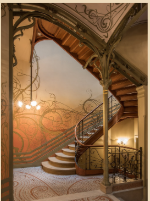
Antoni Gaudí (Spain)
A visionary Spanish architect known for his imaginative and highly symbolic buildings that merge nature, religion, and Catalan culture. His work is part of the Modernisme movement (Spanish version of Art Nouveau).
Casa Batlló (1904–1906) by Antoni Gaudi
A surreal residence with a wavy façade, mosaic tiles, and bone-like balconies
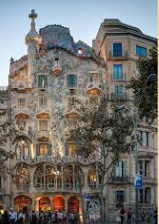
Hector Guimard (France)
brought Art Nouveau to everyday urban life in Paris. His work is best known for combining industrial materials like iron with elegant, plant-like forms, turning utilitarian objects into artistic statements.
Paris Métro Entrances (1899–1904) by Hector Guimard
Iconic cast-iron and glass structures with undulating lines and stylized botanical details

Alphonse Mucha (Czech Republic)
became the face of Art Nouveau illustration through his elegant posters of beautiful women surrounded by intricate floral and ornamental patterns. His style became so influential it was nicknamed the Mucha Style.
Posters for actress Sarah Bernhardt (1890s) by Alphonse Mucha
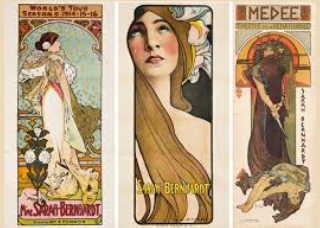
Alphonse Mucha – Job Cigarette Papers Poster (1896)
A commercial poster showcasing a woman with flowing hair, ornate patterns,
and floral backgrounds. A prime example of Art Nouveau’s decorative and graphic
elegance.

Louis Majorelle – Orchid Desk (1900)
A desk with orchid-shaped legs and marquetry depicting flower petals. Majorelle’s pieces are known for being both functional and sculptural.
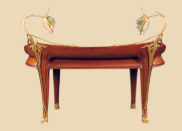
"Dragonfly" Table by Émile Gallé (1900)
This iconic table showcases natural motifs, especially insects and plants. Gallé, a master of marquetry and glass, crafted this wooden piece with detailed inlays of dragonflies and floral patterns. Curved legs and organic lines reflect the essence of Art Nouveau, emphasizing nature’s elegance.
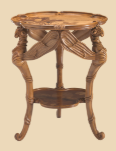
Armchair by Hector Guimard
Around 1898 French architect and furniture designer Hector Guimard created this chair for Castel Béranger, a new apartment building in Paris. Guimard is acclaimed the most representative French artist for the Art Nouveau style.

Art Deco
a shortened version of "Arts Décoratifs"
Art Deco
represented scientific progress, and the consequent rise of commerce, technology, and speed.
ADVANCE
OPULENCE
PRAGMATIC AND CONCEPTUAL
STREAMLINE MODERNE
MODERN MATERIALS
GEOMETRIC SHAPES
PROPERTIES OF ART DECO
William Van Allen
was an American art deco architect who played a significant role in the Art Deco
movement. He is best known for designing the iconic Chrysler Building in New York City, which is widely regarded as one of the most important Art Deco buildings in the world.
The Chrysler Building
a 77-storey skyscraper completed in 1930, was first built as the head office
of the Chrysler Corporation. With its slender shape, complex ornamentation
and stainless steel spire, the structure features a unique Art Deco design.
Although it was never used for that purpose, the spire was initially intended to be a mooring mast for dirigibles.
Lina Bo Bardi
Italian-born who was an art deco architect and designer. She was born in Rome in 1914 and completed her studies in architecture there before relocating to Brazil in the 1940s. She is best known for her creative architectural designs that combined modernist and indigenous Brazilian elements to produce a distinctive look. She was an accomplished curator and furniture designer who made a significant contribution to the growth of the Brazilian design scene
THE GLASS HOUSE
She designed in 1951 in Sao Paulo, is among her best-known creations. The building has a striking modernist style with clear lines, straightforward forms, and a focus on natural light. The Sao Paulo Museum of Art and the SESC Pompéia are just two of the notable structures she created in Brazil during the Art Deco period.
RAYMOND HOOD
American art deco architect became known for his cutting-edge creations in the Art Deco era. He was born in Rhode Island in 1881 and graduated from the School of Fine Arts in Paris and the Massachusetts Institute of Technology. His work in New York, where he designed several remarkable Art Deco buildings.
MCGRAW-HILL BUILDING
The completion of this building in 1931 was one of his most famous designs. The structure had a striking Art Deco style, with a dramatic entry, a stepped tower, and geometric detailing. The Daily News Building, the American Radiator Building and the New York Telephone Company Building are just a few of Hood's other remarkable designs.
LE CORBUSIER
is best known for his modernist architecture, which emphasises usability, simplicity, and a lack of ornamentation. He was a pioneer in the use of reinforced concrete, and his designs frequently had simple lines, sizable windows, and a focus on natural light.
THE VILLA SAVOYE
in Poissy, France, which he designed in 1929, is among his best-known creations. The villa has an eye-catching modernist design that emphasises natural light, a minimalist aesthetic, and a roof garden. His other notable Art Deco creations include the Unité d'Habitation in Marseille and the Swiss Pavilion at the 1930 International Exhibition in Brussels.
1928 Victoire (RENé LALIQUE)
Lalique's sculpture nearly shouts "Art Deco," so exemplary is it of the style
that had by 1930, become the American aesthetic par excellence. Spanning many media and even functions, the style was stamped on everything from luxury ocean liners and racing cars, to toasters and toilets.

1922 État Cabinet (By Emile-Jacques Ruhlmann)
was born in Paris to a family that owned a decorating business, so it seemed only natural that his creativity would find expression in the luxurious home wares for which he became renowned. From furniture and light fixtures to a variety of other decorative elements such as wallpaper, Ruhlmann produced one-of-a-kind, elegant home furnishings using rare, exotic woods with ivory embellishments from Africa and the Far East, thereby incorporating the era's preoccupation with the art of previously considered "primitive" countries.
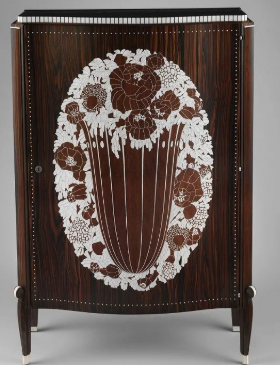
1930 Young Lady With Gloves (TAMARA DE LEMPICKA)
Polish-born painter Tamara de Lempicka became a major proponent of the Art Deco style in Europe and North America, creating high-end stylized, trendy portraits of the famous and fashionable: actors, socialites, and aristocrats. She was rewarded richly for her work, which earned her notoriety and critical acclaim. Lempicka was actively involved in the bohemian scene in Paris during the 1920s, where she befriended Picasso as well as the writers Andre Gide and Jean Cocteau. Her dramatic love life often attracted comment and scandal.
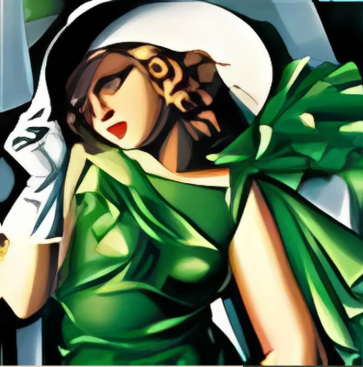
41-230T Table Radio, Bakelite Cabinet
Streamline Moderne is the culmination of the American Art Deco style. It developed during the 1930s and is evident in objects as diverse as elegant skyscrapers to budget-friendly kitchen supplies. This pared-down aesthetic also fit with the more subdued world view prevalent in the U.S. following the 1929 stock market crash. Whereas previous designers often incorporated exotic and expensive materials, Streamline Moderne utilized cheap, readily available industrial materials, such as plastic and chrome.

Louis Süe, Commode, 1918
Lavish gilding, recall the grandeur of the Louis XV period. The subject of its decoration is the Judgment of Paris, a story from Greek mythology. The shepherd Paris was forced to decide which goddess was the most beautiful: Juno, Minerva, or Venus. He is shown awarding the golden apple to Venus, who, as a bribe, promised him the love of any woman in the world; in choosing Helen of Troy, wife of King Menelaus of Sparta, Paris began the Trojan War.
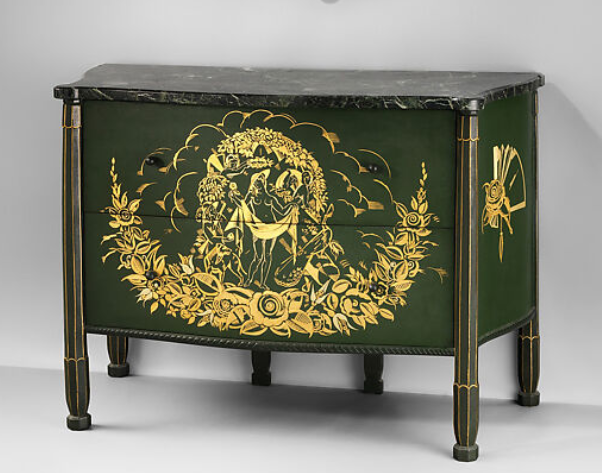
Chaise Lounge
designed by Le Corbusier, Pierre Jeanneret, and the French designer Charlotte Perriand, who worked in the atelier of the Swiss-French architect Le Corbusier and his partner Pierre Jeanneret.

EXPRESSIONISM
is a design and art movement that emphasizes emotional experience over physical reality. In architecture and interior design, it is characterized by bold, abstract, and often organic forms that aim to express inner feelings, moods, or ideas. Rather than following traditional symmetry or order, it focuses on dynamic shapes, dramatic spaces, and symbolic use of materials and light to create an intense, emotional atmosphere.
HISTORY OF EXPRESSIONISM
emerged in the early 20th century, primarily in Germany, as a powerful artistic and cultural movement reacting against the growing industrialization, materialism, and strict academic traditions of the time.
EMOTIONAL EXPRESSION OVER FUNCTIONALITY
DISTORTION AND ABSTRACTION
ORGANIC AND SCULPTURAL FORMS
Symbolism and Spiritual Meaning
Rejection of Traditional Rules
KEY CHARACTERISTICS OF EXPRESSIONISM
1. Asymmetrical forms
2. Jagged edges and bold lines
3. Spire-like elements and dynamic silhouettes
4. Emphasis on verticality and movement
ARCHITECTURAL FEATURES OF EXPRESSIONISM
1. Dramatic lighting (colored windows, skylights)
2. Hand-crafted, custom furniture
3. Wall textures with sculptural finishes
4. Integration of art and architecture as a unified experience
Interior Design Features of EXPRESSIONISM
Erich Mendelsohn
best known for the Einstein Tower (1921) in Potsdam, Germany. This solar observatory was built to support Albert Einstein’s work on relativity, and its striking, organic design symbolized the forward-thinking nature of modern science. The tower’s smooth, flowing concrete surfaces broke sharply from traditional architecture and helped define Mendelsohn’s reputation for dynamic, futuristic structures.
Bruno Taut
was another key figure whose work and theories pushed Expressionism into new creative territories. His Glass Pavilion (1914), designed for the Werkbund Exhibition
in Cologne, was a small yet powerful structure made entirely of glass and
concrete. The building featured colored glass prisms, spiral staircases, and symbolic inscriptions, aiming to create a spiritual and emotional experience for visitors. It was not only a masterpiece of form and light but also a manifesto of
Taut’s belief in architecture as a transformative, almost mystical force
Hans Poelzig
An architect and set designer, made a significant mark with his design of the
Grosses Schauspielhaus in Berli (1919). Originally a market hall, Poelzig transformed it into a dramatic theater space with cavernous interiors, textured ceilings resembling stalactites, and moody, colored lighting. The space evoked a sense of being inside a mysterious cave, intensifying the theatrical experience.
His work highlighted how Expressionist design could evoke deep emotional responses, blurring the boundaries between architecture and performance art.
pyrography (wood burning)
were used to add intricate and symbolic details during Expressionism Era.
EXPRESSIONISM
favored abstract and mystical motifs rather than classical patterns. You might see
sunbursts, flame-like designs, crystalline forms, or eye-shaped patterns integrated into wall carvings, ironwork, and lighting fixtures. Materials like stained glass, wrought iron, and plaster reliefs were often used for expressive detailing.
fresco or encaustic painting
Decorative wall treatments included textured plaster, painted murals, and tapestries that echoed the abstract language of Expressionist painting, often using techniques like —
The Scream (1893) by Edvard Munch
Edvard Munch is regarded as one of the most significant and influential artists of modernism. He was part of the Symbolist movement and pioneered expressionist painting. He was influenced by impressionists and post-impressionists in Paris, such as Claude Monet, Vincent van Gogh, and Paul Gauguin. His career lasted nearly 60 years and produced numerous
modern masterpieces.
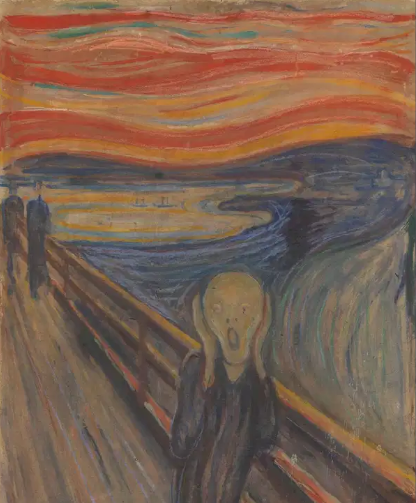
Dance Around the Golden Calf (1910) by Emil Nolde
Emil Nolde was an expressionist painter and a part of the German Die Brücke (The
Bridge) group of expressionist artists. He is remembered as one of the greatest
colorists of 20th-century modernism, using large, rough strokes and contrasting hues to create dynamic pieces. The heightened nature of his work yields emotional
responses in its viewers, creating a relationship between the artist and the audience.
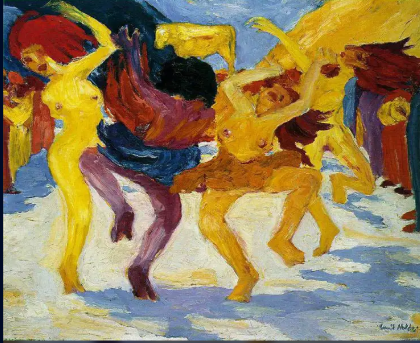
Street, Berlin (1913) by Ernst Ludwig Kirchner
Ernst Ludwig Kirchner, along with Emil Nolde, was a member of the Die Brücke group of German expressionists. His work was characterized by vivid block colors,
wide, contrasting brushstrokes, and sharp, angular forms. His expressive use of color was inspired by the work of post-impressionist and early expressionist
painters Vincent van Gogh, Albrecht Dürer, and Edvard Munch.
SYMBOLISM
was a late 19th-century art and literary movement that originated in
France and Belgium, spreading across Europe by the turn of the century. It emerged as a reaction against naturalism and realism, seeking to represent absolute truths and inner experiences through metaphorical images, dreams, and visions rather than direct depiction of the external world. The movement began in literature, notably with Charles Baudelaire’s Les Fleurs du mal (1857), and was formalized by Jean Moréas’s Symbolist Manifesto in 1886.
KEY CHARACTERISTICS OF SYMBOLISM
more subtle and decorative rather than structural.
Use of symbolic motifs and allegorical figures in ornamentation
and decorative elements.Incorporation of mythological, esoteric, or animal symbols (e.g., rams)
ornamentation that conveys deeper meanings beyond mere decoration.
Victor Horta
was a pioneering Belgian architect whose work is closely associated with both Symbolism and Art Nouveau. The Horta Museum (his former home and
studio) exemplifies Symbolist architecture with its organic forms, curvilinear lines, intricate ironwork, and stained glass depicting natural and mythological motifs.
ANTONI GAUDI
His designs, especially Casa Batlló, are celebrated for their fantastical, symbolic forms inspired by nature and Catalan mythology. The building’s dragon-like roof, bone-shaped balconies, and mosaic façade are hallmarks of Symbolist expression in architecture and interior design.
Albert Van Huffel
His Basilica is a major example of Symbolist architecture with Art Nouveau influences, recognized for its flowing lines, asymmetry, and intricate carvings that evoke spiritual and emotional responses.
"Oedipus & Sphinx” by: Gustave Moreau (1826–1898)
Often regarded as a foundational figure in Symbolism, Moreau’s intricate, allegorical paintings of mythological and biblical scenes set the tone for the
movement. His detailed, imaginative works became a blueprint for later Symbolists.
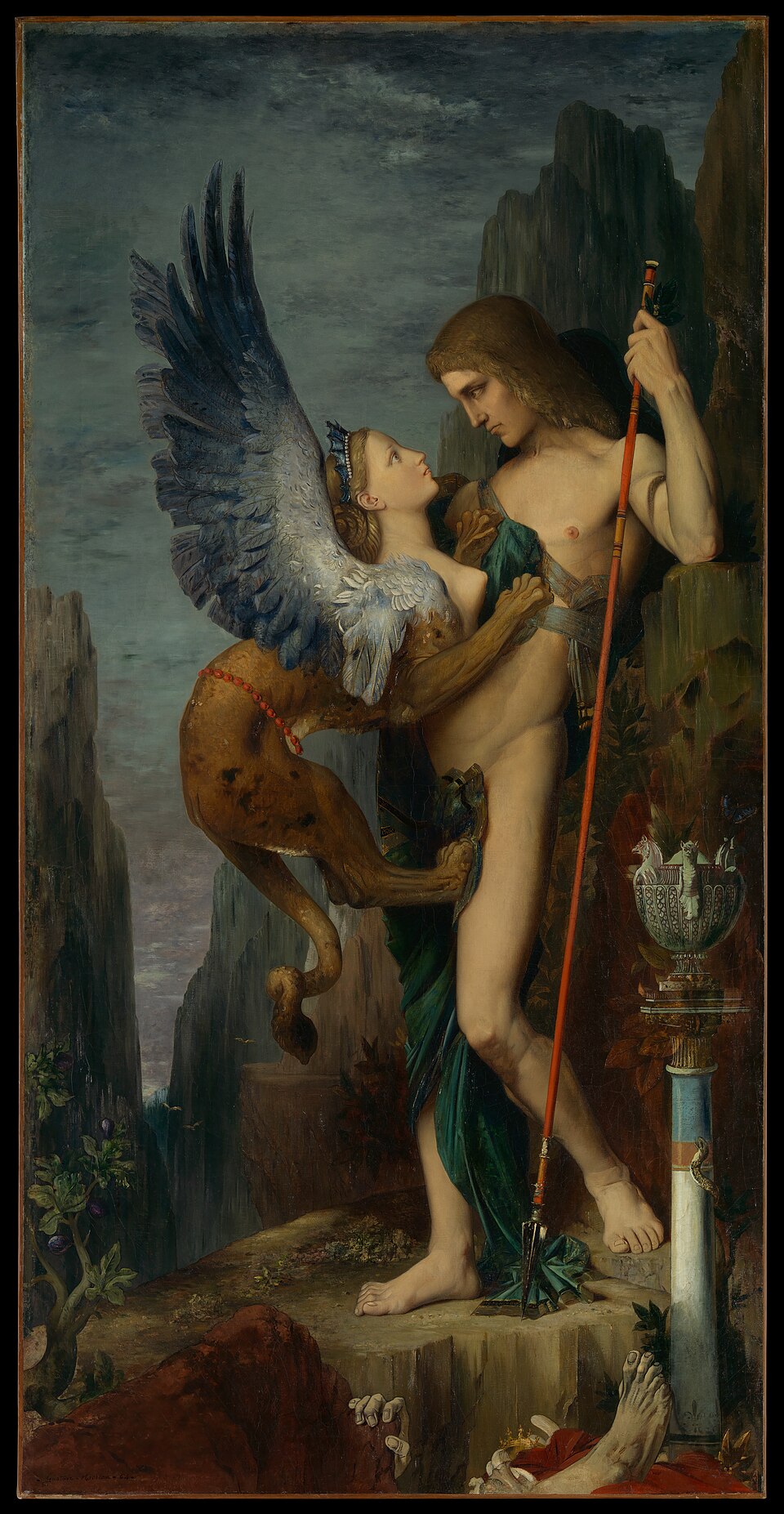
"The Cyclops" by: Odilon Redon (1840–1916)
A French Symbolist celebrated for his dreamlike, fantastical imagery, Redon’s art—ranging from monochromatic “noirs” to vibrant pastels—explored the subconscious and spiritual realms. Works like The Cyclops and The Eye, Like a Strange Balloon Moves Towards Infinity are iconic.

"The Scream" by: Edvard Munch (1863–1944)
The Norwegian painter is best known for this painting, a symbol of existential
angst. Munch’s emotionally charged works explored psychological themes of love, anxiety, and death, making him a bridge between Symbolism and Expressionism.
ANIMAL MOTIFS (rams, peacocks, dragonflies, and mythological features)
FLORAL AND PLANT FORMS (water lilies, vines, and curling stems representing life, growth, and eternity)
MYTHOLOGICAL AND ALLEGORICAL FIGURES (used mainly in carved wood or metalwork)
CURVILINEAR, FLOWING LINES (known as the whiplash line)
USE OF EXOTIC MATERIALS
COMMON SYMBOLIC ORNAMENTATION DURING SYMBOLISM ERA
FAUVISM
is a style of painting and an art movement that emerged in France at the beginning of the 20th century.
It was the style of les Fauves (French pronunciation: [le fov], the wild beasts)
a revolutionary art movement best known for its unapologetic use of bold, vibrant colours and expressive techniques.
les Fauves
A group of modern artists whose works emphasized painterly qualities and strong colour over the representational or realistic values retained by Impressionism
The Salon d’Automne
or Société du Salon d'automne, is an art exhibition held annually in Paris. In 1905, it witnessed Fauvism’s spectacular beginning, a major art scandal at that time. As the years passed, the Salon d'Automne precipitated the emergence of all the major artistic trends of the 20th century: Surrealism, Cubism, Abstraction, New Figuration, and Singular Art.
Charing Cross Bridge, London, 1906 by André Derain
The influence of pointillism is obvious on the right half of the painting, evident by the short choppy brush strokes.

Jeanne with Flowers, 1905-1907 by Raoul Dufy
Depicting Dufy’s sister, Jeanne, with flowers
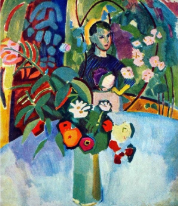
The River Seine at Chatou, 1906 by Maurice de Vlaminck
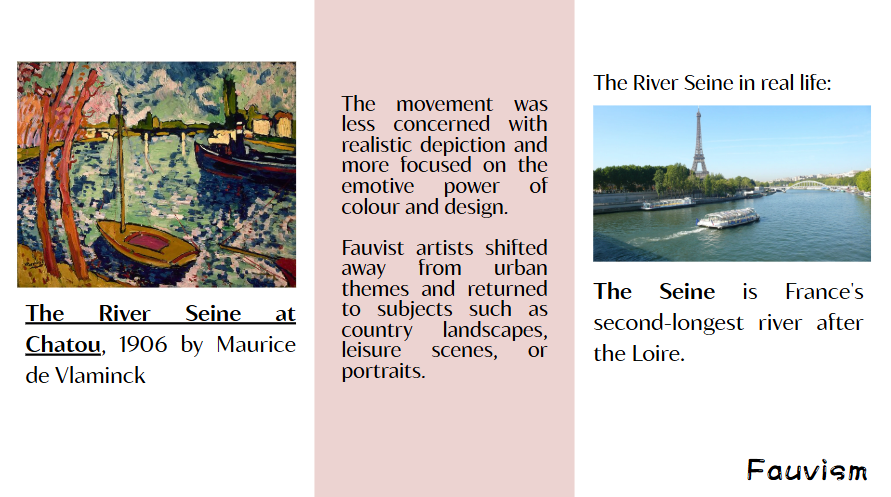
The Dance, 1909-1910 by Henri Matisse
Bright reds, yellows, blues, and greens often clashed harmoniously, creating visual energy and dynamism that would resonate in many aspects of decorative art.
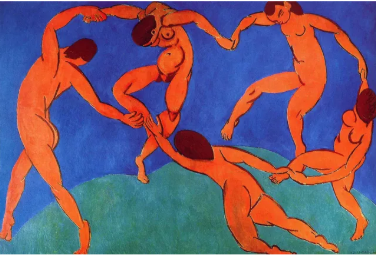
Henri Matisse
is widely regarded as the greatest colorist of the 20th century and as a rival to Pablo Picasso in the importance of his innovations. He emerged as a Post-Impressionist, and first achieved prominence as the leader of the French movement Fauvism.
Luxe, Calme et Volupté, 1904 by Henri Matisse
This is Matisse's only major painting in the Neo-Impressionist mode, and its technique was inspired by the Pointillism of Paul Signac and Georges Seurat.
He differs from the approach of those painters, however, in the way in which he outlines figures to give them emphasis.

The Woman with a Hat, 1905 by Henri Matisse
An image of Matisse’s wife, Amelie.
Matisse roughly applied brilliant color across her face, hat, dress, and even the background.
When he sent the picture to the 1905 Salon d'Automne. Leo Stein called it, "the nastiest smear of paint I had ever seen," yet he and Gertrude bought it for the importance they knew it would have to modern painting.
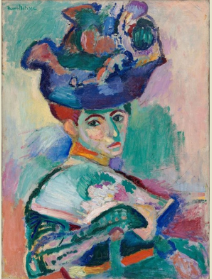
André Derain
Derain was one of the founders of the Fauve artistic movement along with Matisse.
He wanted to give a much greater appreciation to the expressionistic qualities of paint. His works are characterized by dense, vibrant brushworks that attract the viewer's attention as much as the subject itself.
The Dance, 1905-1906 by André Derain
representing an Arcadian landscape with dancing figures, is rooted in the classical primitive tradition. It evokes an amalgamation of traditions including Folk, African, and Romanesque art.
The figures arms and legs are distorted and elongated. The artist emphasizes the rhythmic and sinuous lines of the overall anatomy in order to create a decorative pattern across the canvas. He uses unnatural colors to express primal emotions.
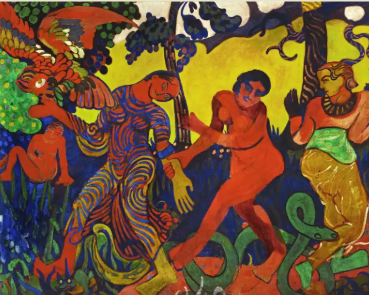
The Dancer, 1906 by André Derain
Her pose, with crossed legs and upper body leaning forward, with that alluring and powerful gaze, raises the question of whether the figure was a dancer or actually something else entirely.
A prostitute could be depicted in a way (through pose, clothing, make-up).
The subject of prostitution was a popular one among Impressionist artists and was noted in works by many including Degas, Seurat, and Toulouse-Lautrec.

Woman with Shawl, 1908 by André Derain
The woman depicted was Madame Matisse.
Woman with Shawl perfectly captures the influence of Japanese art on Fauvism.
First, there is the obvious citation of fashion as the figure is dressed in a kimono. There was an influx of Japanese goods at the time and Japanese fashion was all the rage.
Second, the image shows stylistic parallels with Japanese woodcut prints which had arrived to Paris in the middle of the 19th century and were of great interest to artists seeking new ways to depict forms.

FAUVISM ON INTERIOR DESIGN
Fauvism's influence on architecture and design was more indirect, as it was primarily an art movement.
However, designers who emphasized bold colors, geometric forms, and expressive decoration might have been influenced by Fauvist principles.
INDIA MAHDAVI
Iranian-French Architect and Designer, based in Paris
known for her vibrant approach to interior design and scenography
“I’ve always been influenced by Matisse and how he approaches light through his vision of color. It’s a quest for light, in fact”
The Gallery at Sketch, London
Mahdavi transformed the space into a monochromatic pink environment, creating a surreal and immersive experience. The bold use of a single, vibrant color palette is reminiscent of the Fauvist Principles.
Ladurée Aoyama, Tokyo
The playful and vibrant design echoes the emotional expressiveness found in Fauvism (Covet Edition). Her work continues to embody the spirit of Fauvism, translating its core principles into contemporary interior design.
CUBISM
One of the most influential art movement of the 20th century, it was founded around 1907 and 1908 in Paris by Pablo Picasso and Georges Braque with the aim to reject the traditional techniques of perspective and refuting the idea of art as pure imitation of nature.
By breaking objects and figures down into distinct areas or planes, the artists aimed to propose a revolutionary new approach to represent reality.
GEOMETRIC FORMS (cubes, cylinders, rectangles)
MULTIPLE VIEWPOINTS
EMPHASIS ON TWO-DIMENSIONALITY
MONOCHROMATIC COLOR PALETTE
KEY CHARACTERISTICS OF CUBISM
ANALYTICAL AND SYNTHETIC
TWO DISTINCT PHASES OF CUBISM
ANALYTIC CUBISM
is called ‘hermetic’
ANALYTICAL CUBISM
they appear as a busy interweaving of planes and lines with the subjects fractured, or broken up;
they are painted using a limited range of dark colours (mainly blacks, greys and ochres);
there is very little tonal differentiation used: the general tone of works tends to be muted with a similar dark tone used across the paintings.
SYNTHETIC CUBISM
Simpler shapes
brighter colors,
a variety of textures and patterns, including collages that
incorporate non-art materials such as newspaper or tobacco
wrappers, are pasted on the canvas in combination with painted
areas
collage
this technique further emphasizes the differences in texture and, at the same time, poses the question of what is reality and what is illusion in nature and in painting.
CUBISM IN ARCHITECTURE
Geometric Shapes
Fragmentation
Multiple Perspectives
Abstract Forms
La Maison Cubiste (The Cubist House)
also called Projet d'hôtel, was an architectural installation in the Art Décoratif section of the 1912 Paris Salon d'Automne which presented a Cubist vision of architecture and design. The facade features a highly geometric trim inspired by cubism.
PABLO PICASSO
was a Spanish artist and one of the pioneers of the Cubist movement. He began exploring this revolutionary approach to art in the 1900s, working closely with Georges Braque.
GEORGES BRAQUE
was a French artist and one of the founders of the Cubist movement, alongside Pablo Picasso. He began to explore cubist ideas in his paintings from 1908, and worked closely with Picasso to develop this innovative artistic approach.
Robert Delaunay
was a cubist painter, known for experimenting with cubism in his artworks. the first painter that introduced vibrant color into Cubism and thereby originated the trend in Cubist painting known as Orphism.
ORPHISM
Robert Delaunay originated the trend in Cubist painting known as
JUAN GRIS
was a Spanish painter whose lucidly composed still lifes are major works of the
style called Synthetic Cubism. He executed his first serious paintings in 1910 and adopted the Cubist style the following year.
Albert Gleizes
was a French painter and writer known for his Cubist paintings and his lifelong
commitment to promoting the Cubist movement. A member of Salon Cubist.
The Salon Cubists
a group of avant-garde French artists, who lived and worked in Paris.
Fernand Léger
was a French painter who was deeply influenced by modern industrial technology and Cubism. He developed “machine art,” a style characterized by monumental mechanistic forms rendered in bold colors
machine art
a style characterized by monumental mechanistic forms rendered in bold colors
Les Demoiselles d'Avignon, 1907 by Pablo Picasso
He used distortion of female's body and geometric forms in an innovative way, which challenge the expectation that paintings will offer idealized representations of female beauty.
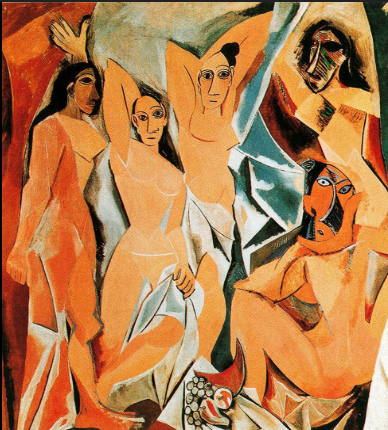
Houses of l'Estaque 1908, Brasque
Braque's paintings made over the summer of 1908 at l'Estaque are considered the first Cubist paintings. The brown and green palette here predicts a palette that Braque employed in many paintings to come.
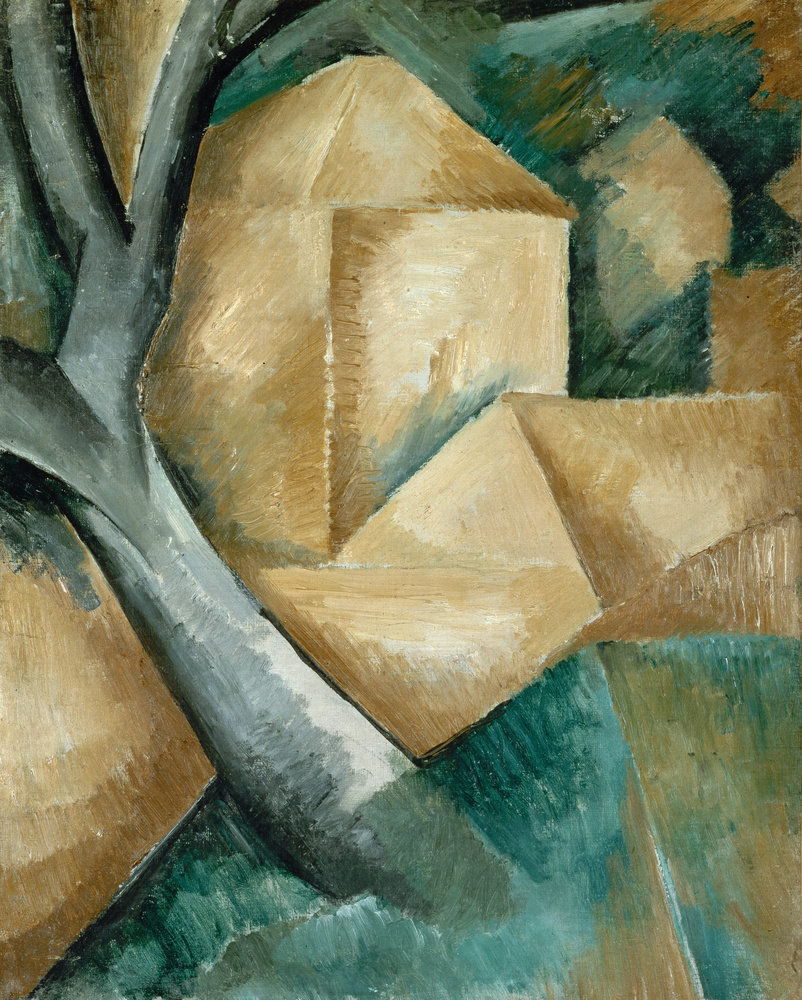
The Red Tower 1911, Robert delaunay
Delaunay explored the developments of Cubist fragmentation more explicitly in his series of paintings of the Eiffel Tower.
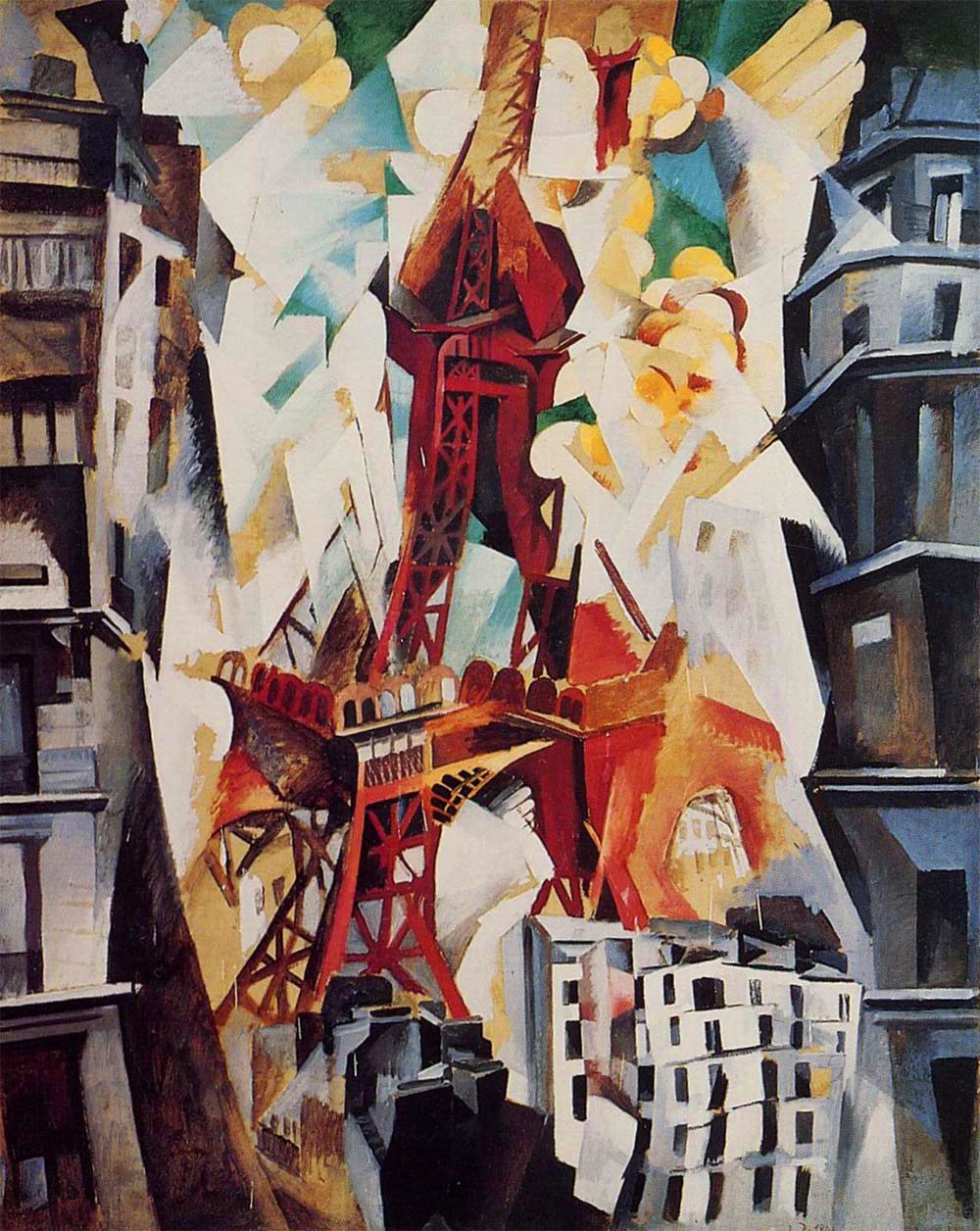
Violin and Playing Cards On A Table, Juan Gris 1913
Here, Gris has painted a wood-grain table with three playing cards—heart, diamond, and club—a violin, and a copy of the newspaper Le Journal.
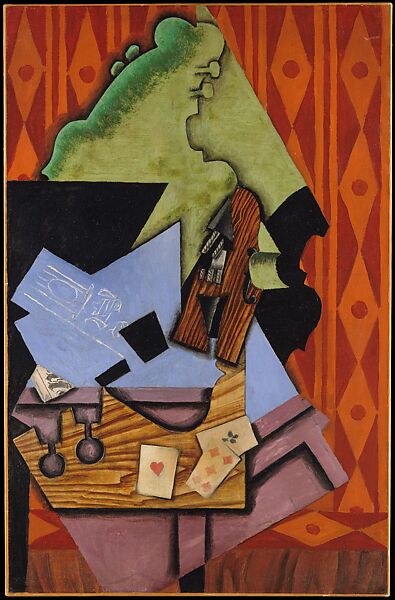
The Schoolboy 1924, Albert Gleizes
Cubism is represented by a gouache from 1924, this painting. An art with dynamic intersections of vertical, diagonal, horizontal, and circular movements.
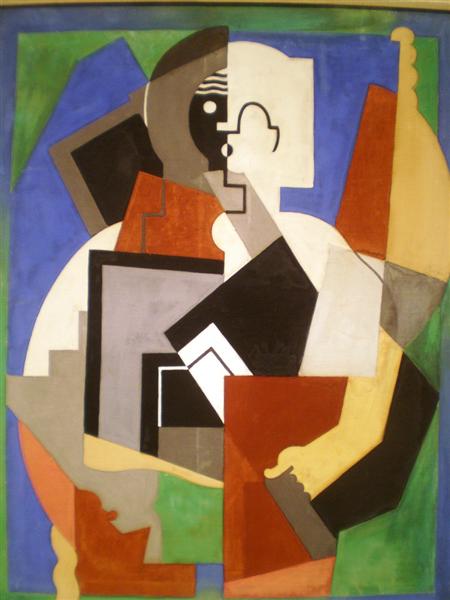
Mechanical Elements, Fernand Léger 1920
Léger's "mechanical period," which lasted from about 1918 to 1923, reflects his infatuation with the machine and with modern technology.

The history of Czech Cubism in architecture
starts in 1912 with the famous installation La Maison Cubiste in an annual Paris
art exhibition.
Instead, cubism found fertile ground in Bohemia (now part of the Czech Republic) where local architects were desperately seeking new artistic expressions. That same year, Josef Gočár, Pavel Janák, and Josef Chochol started the Prague Artistic Workshop. By doing so, they became the founding fathers of the so-called Czech Cubism.
The House of the Black Madonna (Department Store)
is the first cubist building in Prague. It was built in 1912 by Josef Gočár and it houses the only Cubist café in the world called Grand Cafe Orient.
Hodek Apartment Building, Josef Chochol
The façade of the apartment block, built-in 1913-14, reminds us of a folded origami paper. On the facade of the apartment, there are forms that recall a diamond form under the window openings, on the cantilevered roof details.